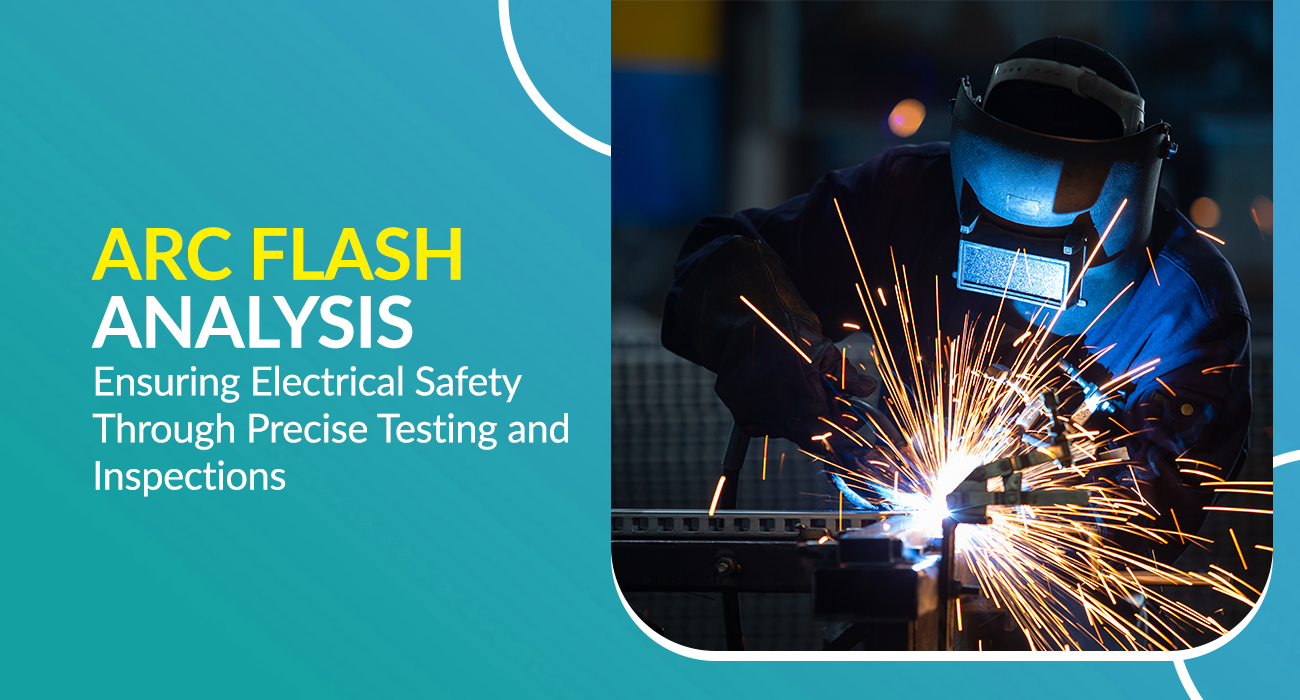
Arc Flash Analysis: Ensuring Electrical Safety Through Precise Testing and Inspections
Electrical systems form the backbone of modern industrial, commercial, and residential infrastructure. While they provide power and convenience, these systems also carry inherent risks, among which arc flash incidents are some of the most dangerous. An arc flash occurs when an electric current jumps through the air between conductors or from a conductor to ground, releasing intense heat, light, and energy. The consequences of an arc flash can range from severe burns and injuries to equipment damage and even fatalities. This makes arc flash analysis an essential practice for every facility relying on electrical systems.
Arc flash analysis is the process of assessing the electrical system to identify and mitigate these hazards. By accurately measuring potential energy release, defining safe working distances, and specifying personal protective equipment (PPE), organizations can create safer environments for employees and protect critical equipment from damage.
Understanding Arc Flash Analysis
Arc flash analysis is more than just a calculation—it is a detailed assessment of electrical systems to understand where and how arc flash hazards can occur. The process evaluates factors such as equipment type, voltage, fault current, protective device ratings, and system configuration. The primary objectives of arc flash analysis include:
- Determining Incident Energy Levels: Calculating the amount of energy released during an arc flash to assess the risk to personnel.
- Identifying Arc Flash Boundaries: Establishing safe distances from energized equipment to prevent injury.
- Specifying Appropriate PPE: Ensuring personnel use clothing and equipment capable of withstanding the calculated energy levels.
- Regulatory Compliance: Meeting standards such as NFPA 70E and IEEE 1584 to maintain workplace safety and avoid legal liabilities.
Proper arc flash analysis requires thorough data collection, precise calculations, and rigorous testing, making inspections and testing an integral part of the process.
The Role of Testing and Inspections
Accurate arc flash analysis relies heavily on detailed testing and inspections. Electrical systems are dynamic, and equipment conditions can change over time due to wear, corrosion, or environmental factors. Routine testing ensures that engineers have reliable data for analysis. Key testing and inspection activities include:
- Insulation Resistance Testing: Determines the condition of electrical insulation to prevent unexpected faults that could trigger an arc flash.
- Continuity Testing: Ensures that conductors and protective devices are properly connected, reducing the chance of unintended energy discharge.
- Circuit Breaker and Fuse Testing: Confirms that protective devices function as intended during overcurrent or fault conditions.
- Thermal Imaging Inspections: Detects overheating components and loose connections that may contribute to arc flash incidents.
- Load and Voltage Measurements: Records actual operational conditions to validate the accuracy of arc flash simulations.
By combining these testing and inspection results, engineers can perform a detailed and reliable arc flash analysis, minimizing the risk to personnel and equipment.
Key Steps in Conducting Arc Flash Analysis
1. Data Collection and System Review
The first step in any arc flash analysis is collecting accurate and comprehensive data about the electrical system. This includes single-line diagrams, transformer ratings, protective device settings, and equipment specifications. Thorough data collection ensures that calculations accurately reflect real-world conditions.
During this phase, inspectors also verify the physical condition of equipment. Issues such as outdated breakers, damaged insulation, or corroded connections can significantly impact arc flash risk and must be accounted for in the analysis.
2. Short-Circuit Analysis
Short-circuit analysis evaluates the maximum fault currents that could occur in the system. By understanding potential fault currents, engineers can identify high-risk locations and determine whether existing protective devices can interrupt the fault quickly enough to minimize arc flash energy. Testing ensures that the short-circuit data used in simulations is accurate, providing a solid foundation for subsequent calculations.
3. Protective Device Coordination Study
A coordination study examines how circuit breakers, fuses, and relays interact during electrical faults. Proper coordination ensures that only the device closest to the fault activates, isolating the problem without affecting other parts of the system. This not only reduces downtime but also minimizes the duration and severity of an arc flash. Inspections during this phase verify that protective devices are correctly installed and functioning according to design specifications.
4. Arc Flash Hazard Calculation
With the data collected and short-circuit conditions evaluated, engineers calculate the incident energy at various points in the electrical system. This calculation considers voltage, available fault current, clearing time of protective devices, and equipment configuration. The results determine the PPE required for personnel and define arc flash boundaries for each piece of equipment. Testing and real-world measurements ensure that these calculations are accurate and reliable.
5. Labeling and Documentation
After completing the analysis, all electrical panels and equipment should be labeled with critical arc flash information. Labels typically include incident energy levels, required PPE, and safe working distances. Detailed documentation is also prepared, which serves as a reference for future maintenance, inspections, and system upgrades. Accurate documentation ensures that new personnel and contractors are aware of hazards and safety measures.
Benefits of Arc Flash Analysis
- Enhanced Worker Safety: Minimizes risk of burns, injuries, and fatalities by defining clear safety measures.
- Regulatory Compliance: Meets international standards such as NFPA 70E and IEEE 1584, helping avoid fines and legal liabilities.
- Equipment Protection: Reduces the likelihood of damage to critical systems, extending equipment lifespan.
- Cost Savings: Prevents downtime, repairs, and potential insurance claims resulting from arc flash incidents.
- Improved Maintenance Planning: Helps identify aging or defective components, allowing proactive replacement before failures occur.
Industrial and Commercial Applications
Arc flash analysis is essential across industries that rely on complex electrical systems. These include:
- Manufacturing Facilities: Heavy machinery and high-voltage equipment increase the likelihood of arc flash incidents.
- Oil and Gas Plants: High-energy electrical systems demand precise analysis to prevent catastrophic accidents.
- Utilities and Energy Providers: Maintaining continuous power supply requires safe handling of high-voltage equipment.
- Construction Sites: Temporary electrical systems can introduce unexpected hazards if not analyzed correctly.
In all these settings, regular testing, inspections, and arc flash analysis significantly reduce operational risks and protect both personnel and assets.
Choosing the Right Service Provider
To ensure accuracy and safety, it is crucial to engage a professional service provider specializing in arc flash analysis. Experienced companies conduct on-site inspections, perform precise testing, and use advanced software for simulations. Their reports offer detailed insights into potential hazards, recommended PPE, and safety measures tailored to specific facilities.
When selecting a provider, consider their experience, certifications, and knowledge of local regulations. Companies that focus on electrical testing and inspections bring expertise that reduces risks, improves compliance, and supports a safer working environment.
Maintaining Safety Beyond Analysis
Arc flash analysis is not a one-time activity. Electrical systems evolve, equipment ages, and new installations may alter system dynamics. Regular inspections and periodic testing are necessary to maintain safety and ensure continued compliance with standards. Additionally, personnel should receive ongoing training to understand arc flash hazards, use appropriate PPE, and follow safe operating procedures.
By combining accurate testing, detailed analysis, and continuous monitoring, organizations can establish a comprehensive electrical safety culture, minimizing the risks associated with arc flash incidents.
Conclusion
Arc flash analysis is an essential practice for any facility that relies on electrical systems. Through systematic testing, inspections, and detailed analysis, organizations can identify hazards, determine safe working distances, and specify appropriate PPE. Routine arc flash assessments protect personnel, ensure regulatory compliance, prevent equipment damage, and reduce operational costs.
Investing in professional arc flash analysis not only safeguards lives but also enhances operational efficiency and promotes a culture of safety. By prioritizing testing and inspections as part of this process, organizations can achieve accurate results, mitigate risks, and maintain reliable electrical systems.





Post a comment